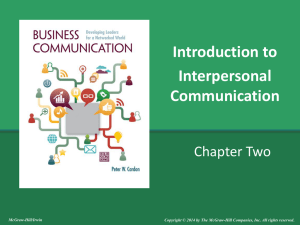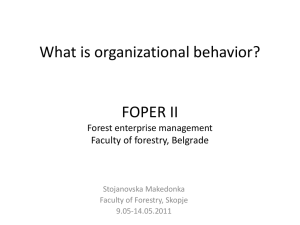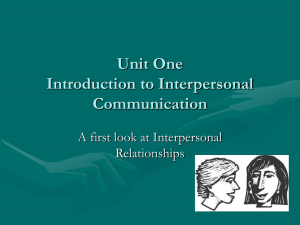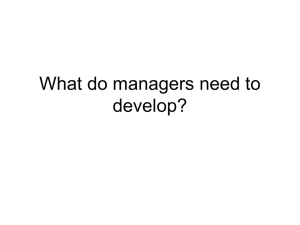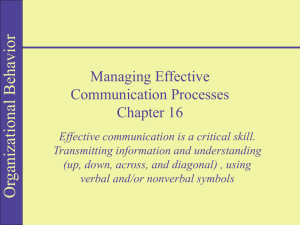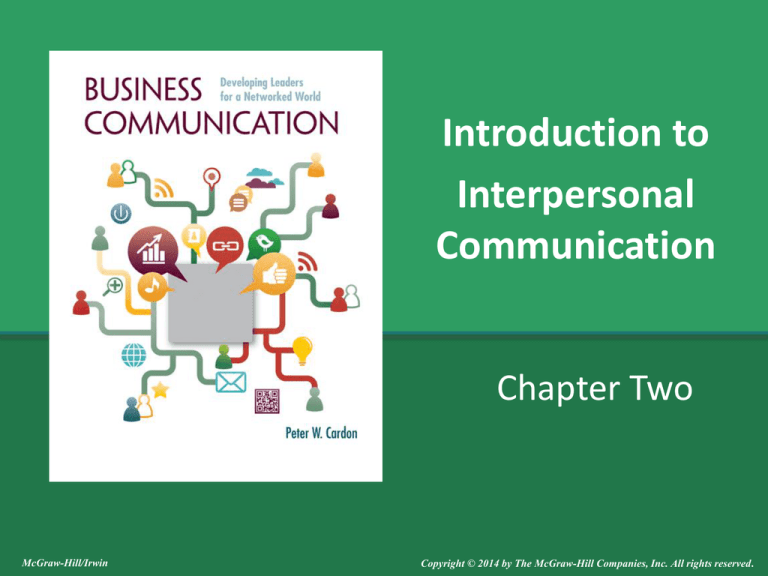
Introduction to
Interpersonal
Communication
Chapter Two
McGraw-Hill/Irwin
Copyright © 2014 by The McGraw-Hill Companies, Inc. All rights reserved.
Learning Objectives
LO2.1 Describe the interpersonal communication
process and barrier to effective communication.
LO2.2 Explain how emotional hijacking can hinder
effective interpersonal communication.
LO2.3 Describe the basic domains of emotional
intelligence and related communication
competencies.
2-2
Learning Objectives (cont.)
LO2.4 Explain the trade-offs associated with richness,
control, an constraints when choosing a
communication channel.
LO2.5 Describe how forms of communication, level of
formality, and communicator styles influence
workplace communication.
LO2.6 Explain the role of civility in effective
interpersonal communication and the common
types of incivility in the workplace.
2-3
Skills That Determine Success
Table 2.1
2-4
Understanding the Interpersonal
Communication Process
Task 1
Overcome barriers
to communication.
Task 2
Manage emotions
to engage in
constructive.
Task 3
Select appropriate
communication
channels.
2-5
Understanding the Interpersonal
Communication Process
Interpersonal communication process,
the process of sending and receiving verbal and
nonverbal messages between two or more
people.
involves the exchange of simultaneous and
mutual messages to share and negotiate meaning
between those involved
2-6
The Interpersonal
Communication Process
Figure 2.1
2-7
Understanding the Interpersonal
Communication Process
Meaning
refers to the thoughts
and feelings that
people intend to
communicate to one
another
2-8
Understanding the Interpersonal
Communication Process
Encoding
the process of
converting meaning
into messages
composed of words
and nonverbal signals
Decoding
the process of
interpreting
messages from
others into meaning.
2-9
Understanding the Interpersonal
Communication Process
One goal of interpersonal communication is
to arrive at shared meaning
Shared meaning
a situation in which people involved in
interpersonal communication attain the same
understanding about ideas, thoughts, and
feelings.
2-10
Barriers to Shared Meaning
External noise
Internal noise
Lifetime experiences
2-11
Noise
Physical noise
Physiological noise
external noise that
refers to disruption
makes a message
difficult to hear or
otherwise receive.
due to physiological
factors
Illness, hearing
problems
2-12
Noise
Semantic noise
occurs when
communicators apply
different meanings to
the same words or
phrases
Psychological noise
refers to interference
due to attitudes,
ideas, and emotions
experienced during
an interpersonal
interaction
2-13
Barriers to Shared Meaning
Filter of lifetime experiences
an accumulation of knowledge, values,
expectations, and attitudes based on prior
personal experiences
2-14
Developing Emotional Intelligence
Emotional intelligence
involves understanding emotions, managing
emotions to serve goals, empathizing with
others, and effectively handling relationships with
others.
2-15
Developing Emotional Intelligence
Emotional hijacking
Figure 2.3
a situation in which
emotions control our
behavior causing us
to react without
thinking
2-16
Domains of Emotional Intelligence
Self-awareness
Relationship
management
Selfmanagement
Empathy
2-17
Domains of Emotional Intelligence
Self-awareness
involves accurately understanding your emotions
as they occur and how they affect you
foundation for emotional intelligence
2-18
Low versus High
Self-Awareness Thoughts
Table 2.3
2-19
Domains of Emotional Intelligence
Self-management
the ability to use awareness of your emotions to
stay flexible and to direct your behavior positively
involves responding productively and creatively
to feelings of self-doubt, worry, frustration,
disappointment, and nervousness.
2-20
Low versus High Self-Management Thoughts
and the Use of Mitigating Information
Table 2.4
2-21
Domains of Emotional Intelligence
Empathy
the ability to
accurately pick up on
emotions in other
people and
understand what is
really going on with
them
Relationship
management
the ability to use your
awareness of
emotions and those
of others to manage
interactions
successfully.
2-22
Strategically Selecting Channels
for Communication
Communication channel
The medium through which a message is
transmitted
emails, phone conversations, and face-to-face
dialogue
2-23
Change in the Use of Communication
Channels During the Past Two Years
Figure 2.4
2-24
Strategically Selecting Channels
for Communication
Strategically selecting a communication
channel means that you choose the one that
is best able to meet your work objectives.
Strategically choosing a communication
channel involves three basic considerations
related to their limitations: richness, control,
and constraints.
2-25
Strategically Selecting Channels
for Communication
Richness
involves the level of immediacy and number of
cues available.
Immediacy
relates to how quickly someone is able to
respond and give feedback.
2-26
Strategically Selecting Channels
for Communication
In high-immediacy communication, people
have immediate access to a variety of cues,
including social cues (turn-taking), verbal
cues (tone of voice), and nonverbal cues
(gestures, facial expressions).
2-27
Strategically Selecting Channels
for Communication
Control
refers to the degree to which communications
can be planned and recorded, thus allowing
strategic message development
Planning
implies that the communication can be tightly
drafted, edited and revised, rehearsed, and
otherwise strategically developed before delivery
2-28
Strategically Selecting Channels
for Communication
Constraints
refer to the practical limitations of coordination
and resources.
Coordination
deals with the effort and timing needed to allow
all relevant people to participate in a
communication.
2-29
Strategically Selecting Channels
for Communication
Resources
deal with the
financial, space, time,
and other
investments
necessary to employ
particular channels of
communication.
2-30
Strategically Selecting Channels
for Communication
Synchronous communication
occurs in real time
the individuals involved give immediate responses to
one another and engage in turn-taking
Asynchronous communication
does not occur in real time
Individuals involved in such communication can pay
attention to and respond to communications at a
time of their choosing
2-31
Forms of Communication
Private communication
One-to-one communication that involves just a
few individuals about work matters
Team communication
Involves communication among team members
that should be shared by and accessible to every
team member
Many-to-many
2-32
Forms of Communication
Networked communication
allows people to contact, communicate with, and
develop work relationships with people they do
not know but who share work interests and goals
Leadership communication
an executive, manager, or other organizational
leader develops a message for all relevant
employees.
2-33
Level of Formality in
Communication
Formality
associated with
protocols, rules,
structure, and
politeness.
Informality
associated with the
absence of protocols
and structure
2-34
Factors Impacting the Formality of
Business Communication
Figure 2.5
2-35
Communicator Styles
Table 2.7
2-36
Incivility in Society and
the Workplace
In a recent survey:
Four in ten respondents (39 percent) said they have
colleagues who are rude or disrespectful.
More than three in ten respondents (31 percent)
said that their workplace supervisors are rude or
disrespectful.
About 30 percent of respondents said they often
experienced rudeness at the workplace,
2-37
Incivility in Society and
the Workplace
Employees who are targets of incivility
respond in the following ways:
Half lose work time worrying about future
interactions with instigators of incivility.
Half contemplate changing jobs.
One-fourth intentionally cut back work efforts.
About one in eight leave their jobs
2-38
Common Types of Incivility
in the Workplace
Ignoring others
Treating others without courtesy
Disrespecting the efforts of others
Disrespecting the privacy of others
Disrespecting the dignity and worth of others
2-39
Maintaining Civil Communications
1.
2.
3.
4.
5.
6.
7.
8.
Slow down and be present in life.
Listen to the voice of empathy.
Keep a positive attitude.
Respect others and grant them plenty of validation.
Disagree graciously and refrain from arguing.
Get to know people around you.
Pay attention to small things.
Ask, don’t tell.
2-40

